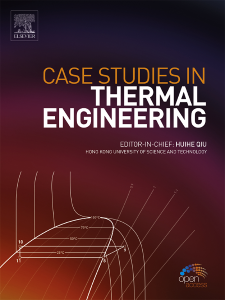Kinetic analysis of coal oxidative pyrolysis before and after immersion effect
IF 6.4
2区 工程技术
Q1 THERMODYNAMICS
引用次数: 0
Abstract
The oxidative pyrolysis kinetics of coal before and after immersion effect was studied by thermogravimetric experiments. Non-isothermal thermogravimetric analysis data were analyzed at four heating rates of 5, 10, 20 and 30 K/min. Furthermore, temperature-programmed experiments and Fourier-transform infrared (FTIR) spectroscopy were employed to understand the oxidation activity and chemical structure of raw coal and soaked coal. After coal immersion effect, the increase in the content of active functional groups, the increase in the concentration of gaseous products, and the decrease in crossing point temperature during oxidation process all indicate that soaked coal is easier to oxidize and spontaneously combust. Lastly, four model-free methods such as Flynn-Wall-Ozawa (FWO), Kissinger-Akahira-Sunose (KAS), Friedman and Kissinger methods are employed to calculate the activation energy (Eα). Kinetic analysis reveals that Eα value obtained by the former three methods significantly depends on the conversion of coal oxidative pyrolysis process, and the average Eα value of soaked coal obtained by four methods is lower than that of raw coal. For the kinetic analysis of coal oxygen adsorption and combustion stages, it is more reliable to adopt the FWO and KAS methods in turn. This research helps to better understand the mechanism of enhanced oxidation activity of soaked coal and optimizes the calculation method of kinetic parameters in different oxidation stages of coal.
浸泡效应前后煤氧化热解的动力学分析
通过热重实验研究了煤在浸泡效应前后的氧化热解动力学。分析了 5、10、20 和 30 K/min 四种加热速率下的非等温热重分析数据。此外,还采用了温度编程实验和傅立叶变换红外光谱(FTIR)来了解原煤和浸泡煤的氧化活性和化学结构。经过煤的浸泡作用后,活性官能团含量的增加、气态产物浓度的增加以及氧化过程中交叉点温度的降低都表明浸泡煤更容易氧化和自燃。最后,四种无模型方法,如 Flynn-Wall-Ozawa (FWO)、Kissinger-Akahira-Sunose (KAS)、Friedman 和 Kissinger 方法被用来计算活化能(Eα)。动力学分析表明,前三种方法得到的 Eα 值明显取决于煤氧化热解过程的转化率,四种方法得到的浸水煤平均 Eα 值低于原煤。对于煤炭吸氧和燃烧阶段的动力学分析,依次采用FWO和KAS方法更为可靠。该研究有助于更好地理解浸泡煤氧化活性增强的机理,优化煤不同氧化阶段动力学参数的计算方法。
本文章由计算机程序翻译,如有差异,请以英文原文为准。
求助全文
约1分钟内获得全文
求助全文
来源期刊

Case Studies in Thermal Engineering
Chemical Engineering-Fluid Flow and Transfer Processes
CiteScore
8.60
自引率
11.80%
发文量
812
审稿时长
76 days
期刊介绍:
Case Studies in Thermal Engineering provides a forum for the rapid publication of short, structured Case Studies in Thermal Engineering and related Short Communications. It provides an essential compendium of case studies for researchers and practitioners in the field of thermal engineering and others who are interested in aspects of thermal engineering cases that could affect other engineering processes. The journal not only publishes new and novel case studies, but also provides a forum for the publication of high quality descriptions of classic thermal engineering problems. The scope of the journal includes case studies of thermal engineering problems in components, devices and systems using existing experimental and numerical techniques in the areas of mechanical, aerospace, chemical, medical, thermal management for electronics, heat exchangers, regeneration, solar thermal energy, thermal storage, building energy conservation, and power generation. Case studies of thermal problems in other areas will also be considered.
 求助内容:
求助内容: 应助结果提醒方式:
应助结果提醒方式:


